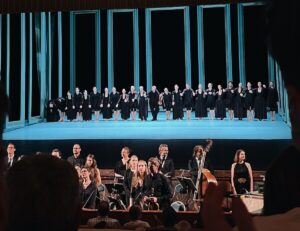Ballet: A Workout for Brain and Body

The last time I was in Paris, it was for ballet class when I was in the eighth grade. Through the language barrier and intimidation factor of taking a class in a new country, I loved my ballet studio here and the opportunity to connect with girls I couldn’t directly communicate with through an art form we all loved. So, this time when I touched down in Paris, I knew that I wanted to find a way to appreciate the thing that brought me here in the first place. After researching with my roommates, we discovered that we would be in Paris over the 250th anniversary of Marie Antoinette’s wedding and that it was being celebrated with a ballet at the Versailles Royal Opera House. So, on a rainy weekend day, we put on our most Versailles-appropriate dresses and made the hour and a half-long journey to the Opera House.

The ballet itself was incredible, with historical context provided on a screen above the stage and the dancers carefully telling the story of Marie Antoinette’s life, death, and antics on stage. Amidst the colorful costumes, contemporary take on classical ballet, and endless violin swells, I felt reconnected to my love for dance; the opportunity to experience that same passion in such a unique way was beyond incredible, and I know that the memory of that night is one I’ll cherish forever.
Connecting this experience back to neuroscience, though, was equally as interesting. Having grown up dancing my whole life, I knew there were lessons I’d learned and habits I’d built that stick with me even today (I still find myself measuring eight-counts in music and counting steps as I walk across a room). But, in light of the courses we’re taking here, I thought it would be interesting to explore the connection between dance and the brain. Through my research, I found an interesting study which explored the relationship between dance and neural plasticity. Specifically, researchers observed structural changes in the hippocampal and grey-matter volume of dancers, as well as heightened levels of white-matter function. These physical differences then led to functional improvements in memory, body balance, and several other realms. The researchers thus concluded that dance can, in fact, improve neuroplasticity by integrating brain regions (Teixera-Machado et al, 2019).

Overall, I think that the opportunity to connect the purposes behind both my visits to Paris was so special, and I’m glad that I had the opportunity to find a way to bring my time here full circle. I know that being here has confirmed my love for both neuroscience and dance, and I am already researching dance studios at home to continue exploring my passions from an ever-increasingly interdisciplinary perspective.
References:
Teixeira-Machado, L., Arida, R. M., & de Jesus Mari, J. (2019). Dance for neuroplasticity: A descriptive systematic review. Neuroscience and biobehavioral reviews, 96, 232–240. https://doi.org/10.1016/j.neubiorev.2018.12.010
